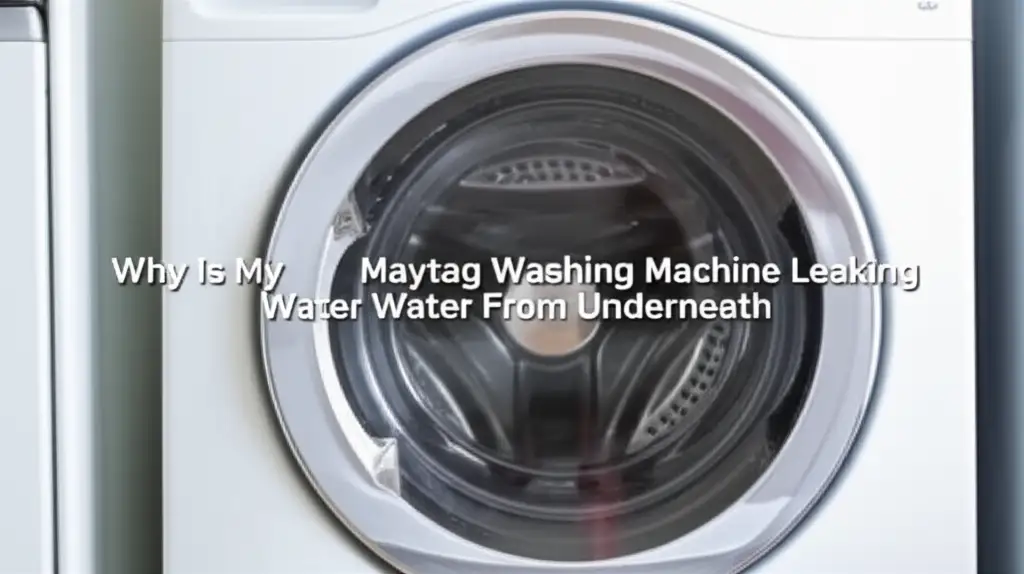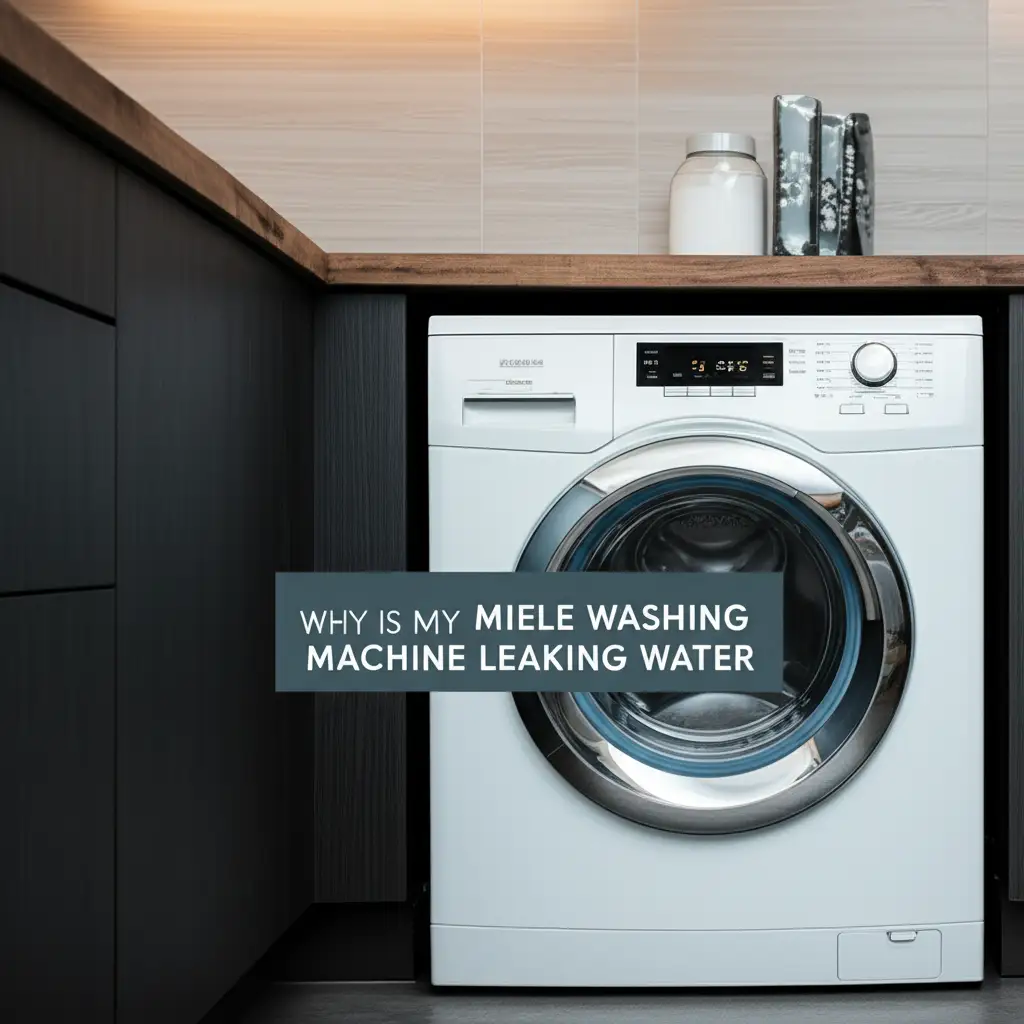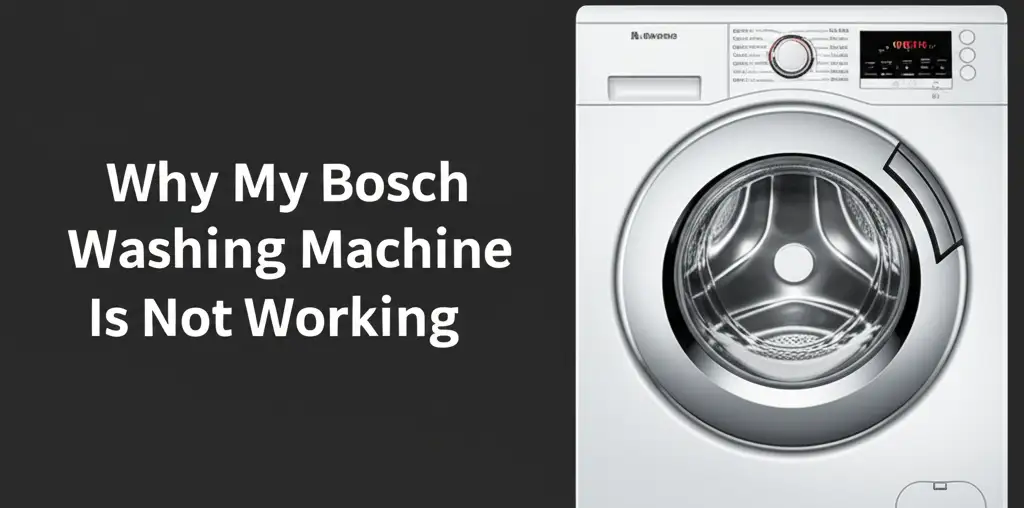· Katria Melrose · Appliance Repair · 19 min read
Why Is My Maytag Washing Machine Leaking Water From Underneath

Troubleshooting Your Maytag Washer’s Underneath Leak
A washing machine leak can quickly turn a normal laundry day into a major headache. The sight of water pooling underneath your appliance is alarming. If your Maytag washing machine is leaking water from underneath, you are not alone. This is a common problem appliance owners face.
Leaks from washing machines often point to a few specific issues. These can range from simple hose problems to more complex internal component failures. Understanding the source of the leak helps you fix it faster. This guide explains why your Maytag washer might be leaking. I will cover common causes and provide actionable steps to identify and resolve them. Let’s get your Maytag washer back to leak-free operation.
Takeaway
When your Maytag washing machine leaks from underneath, start your inspection with the simplest fixes.
- Check all hoses: Ensure they are secure and free of cracks or clogs.
- Inspect the drain pump: Look for damage or blockages.
- Verify the water inlet valve: This component controls water flow.
- Examine the tub seal/gasket: These parts keep water inside the drum.
- Clear the dispenser: Clogs here can cause overflows.
- Address severe issues: A cracked tub or bearing housing often requires professional help.
The main reasons a Maytag washing machine is leaking water from underneath include loose or damaged hoses, a faulty drain pump or its connections, a failing water inlet valve, a compromised tub seal or gasket, or issues with the detergent dispenser or overflow system. Identifying the precise location of the leak is the first step to a successful repair. Many of these problems are fixable with basic tools and some patience.
Pinpointing the Source of Your Maytag Washer Leak
Finding where the water comes from is crucial. You need to identify the exact spot of the leak. Start by moving your Maytag washing machine. This allows you to see the rear and sides clearly. Place towels down to soak up any water. Then, run a short cycle without clothes or detergent. Watch closely to see when and where the water appears. Does it leak during filling, agitation, draining, or spinning? This observation offers important clues. Different leak times suggest different potential issues. For example, leaks during filling often point to inlet hoses or valves. Leaks during draining might indicate drain pump problems.
Inspecting Your Maytag Washer’s Hoses and Connections
Hoses are a frequent source of leaks in washing machines. Both the fill hoses and the drain hose can develop issues over time. Check these connections carefully. You can often fix hose problems yourself.
Water Inlet Hoses
Your Maytag washing machine connects to your home’s water supply with two inlet hoses. One hose is for hot water, and the other is for cold water. These hoses can crack, fray, or loosen at their connections. Inspect both ends of each hose. Feel for dampness or drips at the spigot and washer connections. Look for visible cracks or bulges along the hose length. Over time, rubber hoses can harden and become brittle. Metal mesh hoses can also fray.
If you find a damaged hose, replace it immediately. You can buy new hoses at any hardware store. Ensure the new hoses are robust and rated for washing machine use. Tighten connections firmly by hand, then use pliers for an extra quarter turn. Do not overtighten, as this can strip the threads or crack the plastic components. Maintaining these hoses is a simple step to prevent water leaks. A thorough check here can save you from bigger problems. Consider replacing old rubber hoses with braided stainless steel ones for better durability. Understanding how water flows into your machine can help diagnose related problems, even if your Maytag washing machine is not filling up with water completely.
Drain Hose Issues
The drain hose removes dirty water from your Maytag washer. This hose connects to the back of the washer and typically extends into a standpipe or utility sink. Leaks here are common. Check the connection at the back of the washing machine. Ensure the hose clamp is tight and the hose fits snugly. Also, inspect the hose for any cracks, holes, or kinks along its length. A kink can cause water to back up and potentially overflow, mimicking a leak from underneath.
Sometimes, the drain hose can become clogged. Lint, soap residue, and debris can accumulate inside. A partial clog might restrict water flow, leading to slow draining or even backflow. This backflow can cause water to escape from the machine. Remove the drain hose and inspect its interior. You can use a long brush or snake to clear any obstructions. Ensure the hose is properly positioned in the standpipe. It should not be inserted too far down, which can create a siphon effect and continuously drain water, or be too shallow, allowing water to splash out. Addressing issues with the drain hose is a common first step when your washing machine leaks from the bottom.
Diagnosing Leaks from the Drain Pump or Pump Hoses
The drain pump is responsible for expelling water from your Maytag washing machine during the drain cycle. If the pump itself is damaged or its associated hoses are loose, a leak is likely. Accessing the drain pump usually involves tilting the washer or removing a lower access panel.
Inspecting the Drain Pump
The drain pump on your Maytag washer can leak for several reasons. The pump’s housing might crack, or the internal seals could fail. Often, a small amount of water will pool directly under the pump during the drain cycle. Look for visible cracks in the plastic housing of the pump. Also, check the pump’s motor shaft for signs of rust or water stains, which indicate a failing seal. If the pump is making unusual noises, like grinding or buzzing, alongside a leak, it likely needs replacement. A broken pump cannot effectively move water out of the machine. This can lead to water pooling or backing up within the washer, eventually spilling onto the floor. Replacing a drain pump can be a DIY task for some, while others might prefer professional help. Learning how to perform basic do-it-yourself washing machine repairs can be very empowering.
Drain Pump Hoses and Clamps
The drain pump connects to the washer tub and the main drain hose via smaller hoses. These hoses carry water to and from the pump. Just like the main drain hose, these smaller pump hoses can become loose, cracked, or clogged. Inspect all hose connections leading to and from the drain pump. Check the clamps that hold these hoses in place. Vibrations during cycles can cause clamps to loosen over time. Tighten any loose clamps using a screwdriver or nut driver. Look for any visible tears or holes in these hoses. Even a tiny pinhole can cause a significant leak over time, especially under pressure. Replacing a faulty hose or a corroded clamp is a straightforward repair. This is a common issue seen across various brands, including when a Samsung washing machine is leaking from the bottom.
Understanding a Faulty Water Inlet Valve
The water inlet valve controls the flow of hot and cold water into your Maytag washing machine. This valve has solenoids that open and close based on the cycle selection. If this valve becomes faulty, it can cause leaks. The valve is typically located on the back of the washer, where the water supply hoses connect.
Signs of a Bad Water Inlet Valve
A faulty water inlet valve can manifest in a few ways. You might notice a continuous drip or stream of water leaking from the valve itself, even when the washer is off. This indicates a seal within the valve has failed. During a wash cycle, if the valve leaks, water might appear from the back or underneath the machine. Another sign is if the washer continues to fill with water even when it should not, or if it overfills. This suggests the valve is not closing properly.
Over time, mineral deposits from hard water can build up inside the valve. This can prevent it from sealing completely. Damage to the valve’s plastic housing can also lead to leaks. Replacing the water inlet valve is a common repair. You will need to shut off your home’s water supply before attempting this. Disconnect the water hoses and the electrical connections to the valve. Then, remove the old valve and install the new one. Ensure all connections are secure. Regular maintenance, such as cleaning the screens on your Maytag washing machine’s water inlet valve, can help prevent issues. A leaking water inlet valve is a frequent cause of spills for many washer types, similar to when a Whirlpool washing machine is leaking water from the bottom.
The Role of the Tub Seal or Gasket in Preventing Leaks
The tub seal, or gasket, is a critical component that keeps water contained within the washing machine’s drum. Its location and design vary between front-load and top-load Maytag models. A compromised seal is a very common reason for water to leak from underneath the appliance.
Front-Load Washer Door Gasket (Boot)
For front-load Maytag washing machines, the door gasket, often called the “boot,” creates a watertight seal between the door and the wash tub. This rubber seal is visible when you open the washer door. Over time, this gasket can become worn, torn, or accumulate mold and mildew. Physical damage, like rips from sharp objects in pockets, can also cause leaks. If you see water dripping from the front underneath your Maytag front-loader, the door gasket is a prime suspect.
Inspect the entire surface of the gasket. Look for any cracks, tears, or holes. Check for signs of mold or deterioration, especially in the folds. Sometimes, debris like coins or small pieces of clothing can get trapped in the gasket, preventing a tight seal. Clean the gasket regularly with a damp cloth and mild detergent to prevent mold buildup. If the gasket is damaged, it needs to be replaced. Replacing a front-load washer door gasket can be a bit challenging, requiring careful removal of retaining springs and clamps. However, with the right tools and patience, it is a manageable DIY repair.
Top-Load Washer Outer Tub Seal
Top-load Maytag washing machines use an outer tub seal to prevent water from leaking from the main wash tub. This seal is located around the agitator shaft or wash plate, at the bottom of the inner tub where it meets the outer tub. If this seal wears out, water can seep past it and drip down to the bottom of the machine, appearing as an underneath leak. This leak is often more noticeable during the agitation or spin cycles when water levels are high or the machine is vibrating.
Diagnosing a leaking outer tub seal often involves removing the agitator or wash plate and inspecting the area around the tub opening. Look for water stains or rust marks around the shaft. This type of leak typically means the tub seal is worn or damaged and needs replacement. Replacing the tub seal in a top-loader is a more involved repair. It often requires significant disassembly of the washer, including removing the inner tub. This might be a job best left to an experienced DIYer or a professional technician due to the complexity. However, a failing tub seal is a common culprit for leaks from underneath the machine, as observed in many washer models, including when a Kenmore washing machine is leaking from the bottom.
Addressing Overflow Issues and Dispenser Problems
Sometimes, a leak from underneath your Maytag washing machine isn’t due to a direct component failure but rather an overflow situation. This can happen if the machine fills with too much water or if water escapes from the detergent dispenser.
Overfilling and Pressure Switches
If your Maytag washing machine fills with too much water, it can overflow the tub and leak from underneath. This issue often points to a faulty water level switch, also known as a pressure switch. This component tells the washer when it has reached the correct water level. If the switch malfunctions, it may not signal the water inlet valve to close, causing continuous filling. The water then overflows the wash tub, spilling onto the floor.
To check for this, observe your washer during the fill cycle. Does it seem to keep filling long past the usual point? If water reaches the very top of the tub and then spills over, the pressure switch is likely the problem. The pressure switch connects to an air tube that runs down to the bottom of the tub. If this tube becomes clogged or kinks, the switch won’t read the water level correctly. Clear any obstructions in the air tube. If the switch itself is faulty, it will need replacement. This type of issue is related to water management, and it’s something to consider if your Maytag washing machine is not filling up with water properly in other scenarios.
Clogged Detergent Dispenser
A clogged or overflowing detergent dispenser can also cause water to leak from underneath your Maytag washing machine. Water enters the dispenser during the fill cycle to flush detergent into the tub. If the dispenser drawer or its housing is clogged with old detergent residue, lint, or fabric softener buildup, water may not flow correctly into the tub. Instead, it can back up and overflow the dispenser area. This water then drips down the front or sides of the machine, eventually appearing as a leak from underneath.
Inspect your detergent dispenser. Pull out the drawer if possible and clean all compartments thoroughly. Use hot water and a brush to remove any hardened residue. Check the housing where the drawer sits for any blockages. Ensure the spray nozzles that flush the dispenser are clear. Sometimes, the issue is not the dispenser itself but the water pressure. If water enters the dispenser with too much force, it can splash out. Adjusting water pressure might help, but often, regular cleaning is the best preventive measure. Many Maytag users face similar issues, for instance, when their Maytag washing machine detergent dispenser is filling with water unexpectedly. Keeping the dispenser clean is a simple fix that prevents many unnecessary leaks.
Identifying Leaks from a Cracked Tub or Tub Bearing Housing
While less common than hose or pump issues, a cracked wash tub or a failing tub bearing housing can cause severe leaks from underneath your Maytag washing machine. These problems are generally more serious and often require professional repair or even machine replacement.
Identifying Tub Cracks
The inner and outer tubs of your Maytag washing machine are designed to hold water during the wash cycles. These tubs are typically made of plastic or stainless steel. Over time, especially with heavy loads or imbalances, a plastic outer tub can develop cracks. These cracks allow water to escape, leading to a constant leak during any part of the cycle when water is present in the tub. Finding a tub crack usually requires significant disassembly of the washer. You might need to remove the top panel, agitator (for top-loaders), and even the inner tub to inspect the outer tub thoroughly. Look for hairline fractures or larger splits. If you find a cracked tub, it is a significant issue. Repairing a cracked plastic tub is often not feasible or durable. In most cases, replacing the entire outer tub is necessary, which can be costly and labor-intensive. For some, this might signal the end of the machine’s life.
Tub Bearing Housing Leaks
The tub bearings allow the inner tub to spin smoothly within the outer tub. These bearings are encased in a housing, often located at the bottom of the outer tub. Over years of use, especially with constant exposure to water and detergent, these bearings can wear out. When the bearings fail, the seal around them can also break down. This allows water to leak from the outer tub down the shaft, through the bearing housing, and onto the floor underneath the machine. A failing tub bearing often presents with loud grinding or roaring noises during the spin cycle, in addition to the leak.
Leaks from the tub bearing housing are typically persistent and can cause significant water damage. Repairing this issue involves replacing the tub bearings and their associated seals. This is a highly complex repair. It requires complete disassembly of the washer, often involving splitting the washer tub. Due to the difficulty and the specialized tools required, this repair is usually best performed by a qualified appliance technician. If your Maytag washing machine is making loud noises during spin cycles and leaking, a tub bearing issue is a strong possibility.
General Maintenance to Prevent Maytag Washer Leaks
Regular maintenance is key to extending the life of your Maytag washing machine and preventing unexpected leaks. Simple checks and cleaning routines can identify potential problems before they become costly repairs. Proactive care helps avoid the frustration of a water-logged laundry room.
Regular Cleaning Practices
Keeping your washing machine clean is more than just about fresh clothes. It also prevents leaks. Accumulated lint, soap scum, and mineral deposits can clog hoses, filters, and dispenser components. Run an empty hot water cycle with a washing machine cleaner or a cup of white vinegar once a month. This helps to flush out internal buildup. Pay special attention to the detergent dispenser. Pull out the drawer and clean it regularly to prevent blockages that can cause overflows.
For front-loaders, always wipe down the door gasket after each use. This prevents mold and mildew buildup, which can deteriorate the rubber over time and lead to leaks. Leave the door ajar between washes to allow the drum and gasket to dry completely. Regularly cleaning the lint filter or pump filter, if your model has one, is also crucial. A clogged filter can impede drainage and potentially cause water to back up and leak. Learning how to clean your Maytag washing machine filter for a top-loader without an agitator is a valuable skill. These simple cleaning habits significantly reduce the risk of common leak sources.
Hose Inspection Schedule
Your Maytag washing machine’s hoses are under constant water pressure. They are prone to wear and tear. Make it a habit to inspect all visible hoses at least once or twice a year. This includes the hot and cold water inlet hoses, the drain hose, and any internal hoses if you can access them. Look for cracks, bulges, frays, or kinks. Feel along the hoses for any dampness. Check the tightness of all connections.
Loose connections are a very common cause of leaks. Tighten any fittings that feel loose with a wrench or pliers. If you find any sign of damage on a hose, replace it immediately. Do not wait for it to burst. Investing in high-quality braided stainless steel hoses can offer greater durability and peace of mind compared to standard rubber hoses. By regularly inspecting and maintaining your hoses, you significantly reduce the chances of your Maytag washing machine leaking water from underneath. This small effort can prevent major water damage to your home.
Frequently Asked Questions About Maytag Washer Leaks
Q1: Why does my Maytag washer only leak during the spin cycle?
A leak during the spin cycle often indicates a problem with the drain pump, its hoses, or the tub seal/bearings. The increased vibration and water pressure during spinning can exacerbate existing issues. Check the drain pump for cracks and ensure all drain hoses are securely attached and free of damage. Inspect the tub seal or door gasket for any tears.
Q2: Is it safe to use my Maytag washing machine if it has a small leak?
It is not safe to use a Maytag washing machine with any leak. Even a small leak can quickly become a large one, causing significant water damage to your home. Water and electricity are a dangerous combination. Continued use can also worsen the underlying problem, leading to more expensive repairs or even machine failure. Address the leak immediately.
Q3: How much does it cost to fix a leaking Maytag washing machine?
The cost to fix a leaking Maytag washing machine varies greatly. Simple fixes like tightening a hose might cost nothing. Replacing a drain hose or a water inlet valve can range from $50 to $200 for parts and labor if you hire a professional. More complex issues, like replacing a tub seal or drain pump, could cost $200 to $400 or more. A cracked tub or bad tub bearings might be $400 to $600+, making replacement a consideration.
Q4: Can hard water cause my Maytag washer to leak?
Yes, hard water can contribute to Maytag washer leaks. Mineral deposits from hard water can build up inside the water inlet valve, preventing it from fully closing and causing drips. These deposits can also accumulate in hoses and the detergent dispenser, leading to clogs and potential overflows. Regular cleaning and descaling can mitigate these effects.
Q5: What should I do immediately when I find water underneath my Maytag washer?
When you discover water underneath your Maytag washing machine, immediately stop the cycle and unplug the washer from the electrical outlet. Turn off the water supply valves connected to the washer. These are usually on the wall behind the machine. Mop up the water to prevent floor damage. Then, begin troubleshooting to find the source of the leak.
Q6: How do I access the parts underneath my Maytag washer for inspection?
Accessing parts underneath your Maytag washer typically involves tilting the machine back slightly or laying it on its side (ensure it’s completely empty of water first). Some models have a removable kick panel at the bottom front that provides access. Always unplug the washer before attempting any inspection or repair. Consult your Maytag washer’s owner’s manual for specific access instructions.
Conclusion
Discovering your Maytag washing machine is leaking water from underneath can be frustrating. However, many of these leaks stem from common, identifiable issues. By systematically checking your washer’s hoses, inspecting the drain pump, evaluating the water inlet valve, and examining the tub seal or gasket, you can often pinpoint the problem. Remember to also consider overflow issues from a faulty pressure switch or a clogged detergent dispenser.
Addressing these issues promptly not only prevents further water damage but also extends the life of your appliance. While some repairs might require professional assistance, many common leaks are fixable with basic tools and a bit of DIY spirit. Regular maintenance, including hose inspections and proper cleaning, remains your best defense against future leaks. Don’t let a small drip turn into a flood. Take action today to ensure your Maytag washing machine operates efficiently and leak-free for years to come. Your laundry room will thank you for it.





